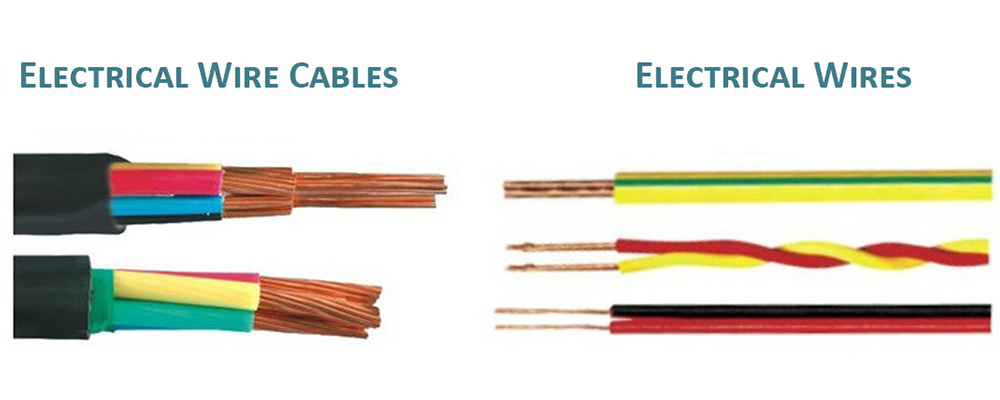Although wire & cable are sometimes used synonymously in the context of electrical equipment, they really have separate meanings. Anybody working with electricity has to know the difference between a wire and a cable since it affects the effectiveness and safety of your electrical system. What precisely separates a wire from a cable, then?

What is a Conductor?
Before learning the differences between wires and cables, let’s define a conductor. Any substance that permits easy electric current passage through it is considered a conductor. The two most often utilized conductors are aluminum and copper.
What is a Wire?
A wire is a form of conductor that is uninsulated. It is also referred to as a “Taar” in Hindi. Because they lack insulation, transmission lines—which are used to transfer electricity over great distances—are an example of a conductor that is classified as a wire.
Types of Wires
Solid wires and standard wires are the two primary categories of wires. Standard wires consist of a bundle of thin, flexible conductors, whereas solid wires are composed of a single, solid conductor.
| Solid Wires | Standard Wires |
|---|---|
| When bent too much, solid wires become less flexible and are more likely to break. They are frequently utilized in motor windings and other applications where flexibility is not a big problem. | In contrast, standard wires consist of a collection of pliable, thin conductors bundled together. They become more pliable and simpler to bend without breaking as a result. In many different electrical applications where flexibility is crucial, standard cables are frequently utilized. |
What is a Cable?
One kind of conductor with insulation surrounding it is a cable. There are many different kinds of cables, including coaxial, single-core, and multi-core cables. The main distinction between a cable and a wire is that the latter lack insulation surrounding the conductor.
Types of Cables
Some common types of cables include:
- Single-core cables
- Multicore cables
- Coaxial cables
- Twisted-pair cables
- Fiber-optic cables
Wire & Cable Advantages & Disadvantages
| Advantages | Disadvantages |
|---|---|
| Cables | |
| – Cables are more durable and resistant to wear and tear. | – They can be more expensive than individual wires. |
| – They offer better protection against interference and noise. | – Repairing or replacing a damaged cable can be more complex. |
| – Cables are easier to install and manage, especially in complex setups. | – They may have higher capacitance and inductance, affecting signal transmission. |
| Wires | |
| – Wires are more flexible and can be easily maneuvered. | – Individual wires may be more prone to damage if not properly protected. |
| – They are usually more cost-effective for simple installations. | – Wires may be more susceptible to interference and crosstalk. |
| – Repair and replacement of individual wires are simpler and cheaper. | – Managing and organizing multiple wires can be challenging. |
Identifying Wires and Cables
You can be asked to determine whether a certain conductor is a cable or a wire during an electrical interview. It’s important to check if insulation surrounds the conductor:
• A conductor is a wire if there is no insulation surrounding it.
• If the conductor has insulation surrounding it, it is a cable; otherwise, wires are used in situations where the conductor is exposed, such as in motor windings or transmission lines. In situations like home wiring or data transmission, when the conductor has to be safeguarded, cables are utilized.
It’s crucial to understand that a conductor’s size or cross-sectional area (such as 1.5 mm2) does not define whether it is a wire or a cable.
Answering Interview Questions
When answering interview questions about the difference between wires and cables, it’s important to focus on the presence or absence of insulation around the conductor. Avoid getting caught up in technical details about the size or cross-sectional area of the conductor, as that is not the primary factor in distinguishing between wires and cables.
Remember, if the conductor has no insulation, it is a wire. If the conductor has insulation, it is a cable. This simple distinction is the key to answering these types of interview questions effectively.
I hope this blog post has helped you better understand the difference between wires and cables, and how to approach related interview questions. If you have any further questions or need additional clarification, feel free to reach out. Happy learning!
FAQs
Can I use a wire instead of a cable for my networking needs?
- While technically possible, cables are designed specifically for networking applications and offer better performance and reliability.
2. Are all cables made of copper?
- No, cables can be made of various materials, including copper, aluminum, and fiber optics, depending on the application.
3. What is the difference between a wire and a cable in terms of flexibility?
- Wires are generally more flexible than cables, which can have multiple insulated wires bundled together.
Also you may Know – Free – Understanding Indoor Lighting Basics













